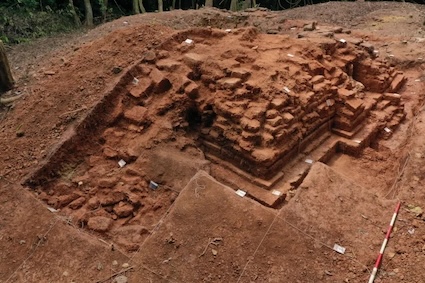Ancient find reveals new evidence of Malaysia’s multicultural past

The “Ancient Kedah Kingdom” prospered between the 2nd and the 14th century CE, stretching across the northwestern coast of the Malay peninsula and into Thailand predating the arrival of Islam in the region.
(Aljazeera) – Until six months ago, none of the inhabitants of the village of Bukit Choras, set amid rice fields near the steep and lush hill of the same name in northwestern Malaysia, had any idea they had been living next to an archaeological wonder all their lives.
It was only after a team of 11 researchers cleared the thick bushes and secondary jungle from the top of the hill, and gently scraped away at the soil that a missing piece of Southeast Asian history was revealed.
The 1,200-year-old Buddhist stupa of Bukit Choras was discovered last August in Malaysia’s Bujang Valley – a river basin scattered with several clusters of protohistoric sites in the country’s northwestern Kedah state.
The stupa is the best preserved in the country and experts say it could hold the key to Malaysia’s long history of multiculturalism.
“This site is an anomaly because it stands all by itself,” Nasha Rodziadi Khaw told Al Jazeera. Nasha is the chief researcher of the team from the University of Science Malaysia’s Global Archaeology Research Centre (CGAR) in the northwestern island of Penang, who supervised the excavation between August 28 and September 12 last year.
Bukit Choras is situated near the small town of Yan on Kedah’s southern coast about 370km north of the capital, Kuala Lumpur.
Unlike the 184 archaeological sites previously identified in the Bujang Valley, which lie to the south, the stupa is isolated on the northern side of Mount Jerai, which was once a cape and a pivotal navigation point for seafaring traders who ventured to this part of the world from as far as the Arabian peninsula.
“We are still not sure of Bukit Choras’s function. It may have been a military garrison or coastal trade outpost, but we need to do further excavation [to assess]. Based on our preliminary findings, it shows plenty of similarities with other sites found in Java and Sumatra, Indonesia,” said Nasha, whose team will continue to work at the site throughout the first half of 2024.
A forlorn discovery
According to Nasha, Bukit Choras was first reported in 1850 by a British officer looking for treasures, and then, in 1937, briefly studied by another British scholar, HG Quaritch Wales. Wales undertook some minor excavations, but only reported finding a squarish Buddhist stupa, taking note of its measurements. He never provided any illustration or plate for the site.
Nearly 50 years later, in 1984, the then-director of the Bujang Valley Archaeological Museum returned to Bukit Choras to do some site cleaning and documentation, but the site remained largely undisturbed.
“I realised that nobody had done proper investigation [since then] and managed to get a fund to survey the site in 2017,” Nasha told Al Jazeera.
“We used electronic waves to do physical detection of what was hidden underground and found there were some big structures underneath.”
Nasha received more funding from Malaysia’s Ministry of Higher Education to conduct proper excavations in 2022, and his team was stunned to discover how well-preserved the site was compared with those unearthed in the Bujang Valley between the 1930s and 1950s – some of which had deteriorated because of erosion, human activities and even accidental destruction.
“At first we only excavated 40 percent of the whole Bukit Choras site, finding a stupa about nine metres long,” said Nasha. “But the most important discovery was two stucco statues of Buddha in good condition that have never been found in the area before.”
Stucco, Nasha explained, was thought to only be found in Java and Sumatra in neighbouring Indonesia, as well as in India, at the time.

